The skeleton started out like this:
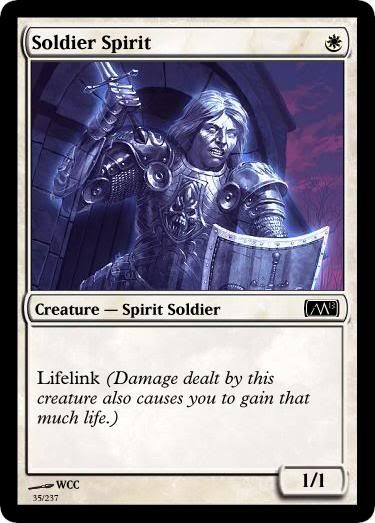 | 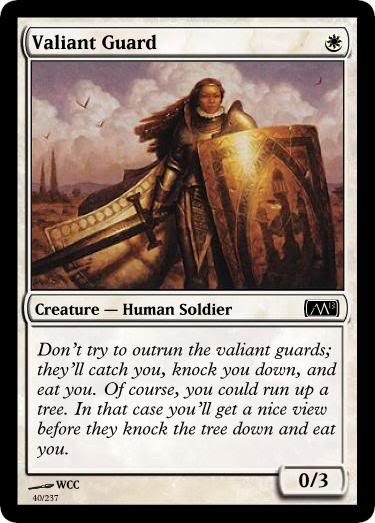 | |
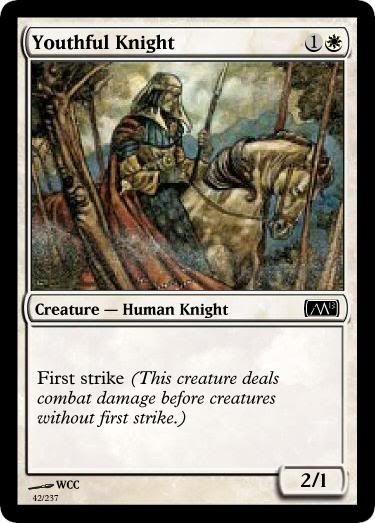 |  | 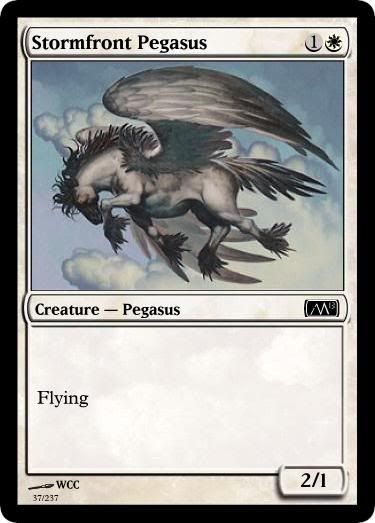 |
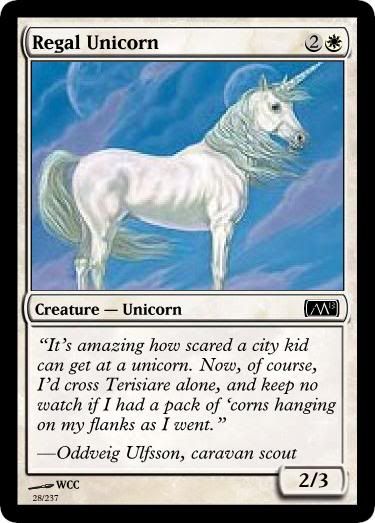 | 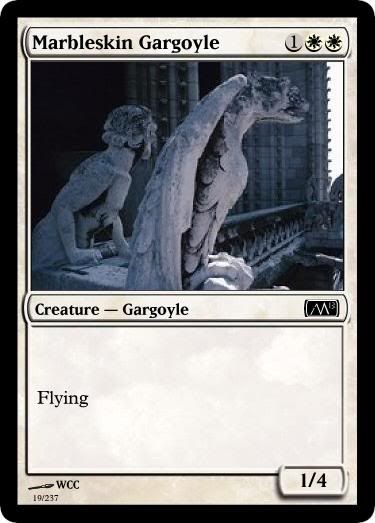 | |
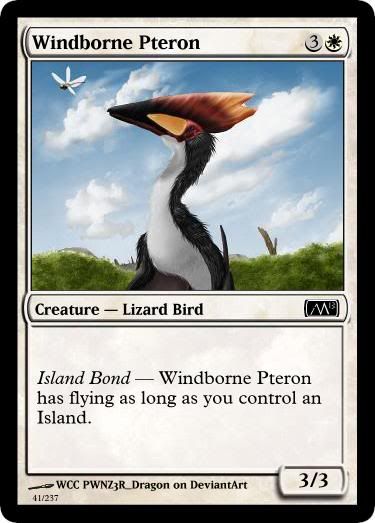 |  |  |
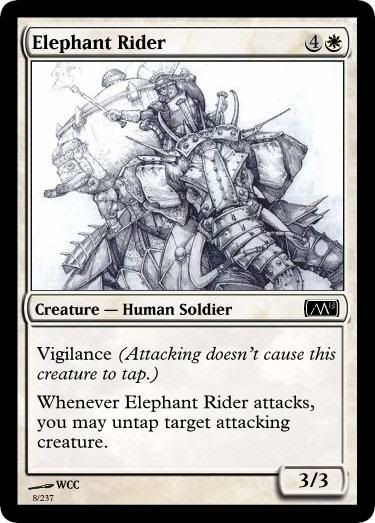 |
The first decision to make was the size of the White Bond creatures, since Bond creatures are the centerpiece of the set. I considered making the Windborne Pegasus a 3/1 for 1W, like this:
Looking at the card, it seemed splashy enough to be exciting, but also very harsh on opponents since it would start dishing out a lot of damage without giving them much time to react. I've definitely experienced some frustrating Limited environments where you need to have the right card at the right time or lose quickly.
At first I considered the possibility that even if this card is powerful, if it's just one card, maybe other answers cards can be seeded into the environment so that players can handle it. We had a cantrip 1 damage spell in Red already. There could be a Blister Beetle in black. White could have a 2/1 first strike flyer for 3 mana. Other colors could get cheap reach creatures, or 1/1 flyers that were designed to be main-deckable.
But the more I thought about it, the more that approach seemed wrong. Even if that plan for seeding answers worked, it would feel like getting players excited about the Pterons, and then disappointing them with underperformance. It would be hard to hit the right spot where answers were available but the Pterons still felt good. I thought about the appeal of core set Limited, and it just seemed to me that it didn't need to be about power-creepy excitement. If anything, core set Limited should serve as a reset button between the power-creepiness of expansion sets. (Although I do appreciate an occasional well-placed Gorehorn Minotaurs, or a splashy-but-not-broken card like Garruk's Companion). While the cards have to be fun or exciting to play in some way, the commons shouldn't provide excitement at the cost of requiring a narrow category of cards like removal or flyers right in the first few turns.
Perhaps it can be argued that finding that "feels-broken but can be answered" spot is a big part of Magic set design. It may have been better to test this anyways.
This card did make me think of a potential benefit of the Bond mechanic, though: The Pterons could exist side by side with dangerous creatures such as a Kird Ape or a 1B 1/1 creature that gets +2/+0 when you control a Mountain (which I was also considering), and no deck would be able to scrounge them all up and play them to full effect. We were mostly thinking about Bond as a safe way of splashing many Bond creatures, but Bond also serves as a mechanic that limits the combination of cards that get played together. While that's not the main benefit we are aiming for, the mechanic has been a factor for inducing archetype-oriented play. I open up a Sealed pool and see 4 Kird Apes. I don't think "Here's 4 A+ Red cards, so it's an auto-choice to play Red. Now what's my other color?" I look to the rest of my pool and think, "What does my RG hyper-aggro route look like? Is it better than my UB flyers route?"
Anyways, I decided to go with 1W 2/2, a size which Jay Treat had suggested. It replaces the Stormfront Pegasus's slot, which I was actually glad of. I've always been peeved by how White's flyers have around the same power as ground creatures of the same cost. Not only does it seem unfair, I also believe it would be good for archetype diversity if a higher percentage of flyers had lower power than ground creatures. The flyer decks would have to diverge into two schools — some flyer decks would focus on temporary tricks like bounce spells and Frost Breath for a quick win, while others would try to control the board with spells and defensive creatures and win with a few good flyers.
While I was glad to give Stormfront Pegasus some time off and see what happens, it also seemed fair enough that the color pair of White-Blue, the king of flyers, could still get a good 2-drop flyer with power 2. Once again, like the Kird Ape, Bond seems to be good at defining iconic cards that represent their color-pair archetypes, at least for these aggro cards.
Then I worked on the rest of the creatures from low cost to high. First of all, I didn't like the current 1-drops. These slots had been filled in last, and honestly speaking, they looked like to me like throwaway designs to fulfill the vanilla and French vanilla quotas.
Some people thought the 1/1 lifelink would be good in an Aura deck. I wasn't sure about that; it's still going to get you 2-for-1ed and the situationality is a real downside. Even in a deck built for it, you are going to have to cast an Aura on another creature in a large number of games and then these guys would be mediocre. Even if it did work, White is the weenie color and it really deserves to have a 1-drop that is functional and main-deckable in most decks.
The vanilla 0/3 serves a respectable purpose as a sideboard card against Kird Ape, a common card in our set, but while working out the Blue cards, I felt that in this version of the skeleton Blue would need to use that vanilla size more. With the Bond changes I was working in, Blue just couldn't fit in 2 distinct-feeling vanillas sizes if it couldn't use a 0/4 as one of them. One of the reasons for that was that White had a 1/4 already and that prevented me from using a Horned Turtle as one of the Blue vanillas since that would be too much early defense alongside White's 1/4.
I considered Infantry Veteran or Soul Warden. I put in this flyer which I wanted to experiment with:
I've always wanted to make White and Green work together more often, and wondered what a White-Green fatty deck would look like if such a thing could exist. I hoped this would support such a deck, while being generally useful in the set because of the large number of dangerous flyers with toughness 1 in the set, with sizes like 3/1 or 2/1 with lifelink.
Unfortunately, many test players didn't realize this card had flying because of the picture, but the focus was meant to be on the Birds rather than the Elephant. (Some birds have a symbiotic relationship with large animals such as elephants or water buffalos, by eating the small bugs that infest them). If we were to keep this card, it may need a different card art.
In testing, it seemed pretty decent even with occasional life gain, but it hasn't necessarily inspired a WG deck yet.
Then I went on to the 2-drops. Unlike most sets, our White 2-drops all had power 2. While that was a larger number than usual, it could be a feature rather than a bug. It would be cool if White's identity as the weenie color in Constructed could be carried over into Limited in that way. M10 achieved that with the Soldier tribal theme. M11 and M12 achieved that by increasing the number of flyers White gets, to a point where it gets more than the main flying color, Blue. While that doesn't necessarily feel like a weenie swarm, it did allow White to be aggressive and militant.
It must be hard to make White into an aggro weenie color in core sets, because every color gets some 2-drops and they all tend to trade with each other. How can you out-swarm the opponent when your guys are just going to trade? First strike could be used on a White 2-drop weenie creature to make it superior to other color's bears, but the first strikers can also be just as much a board-stall factor as an aggro factor. A single Youthful Knight could hold back several 2/1s, 2/2s and 3/2s. That must be the reason why M11 and M12 looked to flying as a way of making White better at attacking with small aggro creatures. (By the way, I believe bringing back the phrase "First strike while attacking" on cards would be nice for encouraging attacks).
I felt it would be interesting to try to encourage a ground weenie style somehow. I added another 2-drop: Blade of the Sixth Pride. It was actually one of the few White vanilla sizes that could be used, since sizes such as 2/2, 1/4, etc had been used up by non-vanilla cards in the file already. A 3/5 couldn't be used either, since I was considering a 3/6 Bond creature in Blue. While that's not an exact overlap, there might be too much defense if both were allowed to exist side by side.
Jules designed this card to nerf tappers without making it feel like it's strictly worse. Some players felt it was cool that the numbers 2 sync up, and that you have a real choice about whether to attack with it or save it for tapping.
This card always seemed very weird to me. I want there to be a variety of high power offensive creatures and low-power utility creatures at each point in the curve so that decks can have different options for what they want out of their turn-2 play. I want to avoid cards that serve both a beater role and a utility role so that cards have a clear, unified identity as well as contrast well with other cards in the same mana cost. I may have been too caught up in some kind of "mana curve design" perspective, but from my perspective, this is what the card looked liked:
But many of the others felt the 2/2 tapper was very cool. Also, I could appreciate the aspect of nerfing tappers. Tappers can be really mean to Auras and fatties, and the ability to keep changing their targets to whatever is most dangerous, or to tap two creatures down for a final attack, is so flexible and powerful against removal-light decks. Tappers are so powerful, they're on par with pingers and looters, but while pingers and looters appear at Common less often, tappers keep appearing.
I liked the idea of nerfing tappers, so I tried changed the wording to "tap target nonwhite creature" to nerf it even more. Jay had been proposing putting the phrase "Target nonwhite creature" somewhere on a White removal spell since it is flavorful for White to not want to kill its own. Tapping can be considered a kind of removal, and putting the nonwhite clause on this creature could help nerf tapping even more.
I don't think it would be a good idea to put the restriction of "target nonwhite creature" on another removal spell that is already restricted or counterbalanced in some way. I personally think it's best when each removal spell has one simple drawback or restriction if possible. For example, Pacifism is already restricted from being undoable with a Naturalize or bounce spell, Condemn is already restricted to removing only attacking creatures, and Path to Exile already has the drawback of giving the opponent a land. Putting "nonwhite" on those cards would muddy the considerations players have to make when evaluating the card in a draft or deciding when to cast the spell in a game. Arguably, a card like Vendetta already does that, but it seemed better to keep things simple, especially if the main motivation for making the change is flavor. But a Tapper didn't start out with such restrictions, and it was for a card that could use some nerfing for mechanical reasons, so the clause seemed to fit well here. I tried to reconcept the card to match the change and it became this:
Once I made it into a Paladin, it started to all make sense to me as a card. Knights are often overpriviliged with abilities, and are 2/2s for 2 mana. A Paladin wields holy magic, but is slightly more clumsy with it than a cleric, so the higher activation cost makes sense. The "nonwhite" clause makes it feel as if it is wielding some kind of holy light that affects only impure creatures. We would get the tapper nerfage Jules intended, the flavor for white removal Jay wanted, and it looks like a unified card so I don't hate it.
I decided to give White four 2-drops in this test file, to get a higher number of power 2+ weenies than usual. But I didn't want to make the creatures all have high power, so I changed the Youthful Knight to this card:
Then I went on to the 3-drops.
I kept the Regal Unicorn. A 2/3 Vanilla hasn't appeared in core sets because it could make 2-drop bears bad to play. And when 2-drop bears are bad, tempo suffers. At least, that's what I'm guessing. In one of the Development articles on Dailymagic.com, I've read that recent Development technology allows for such sizes as 2/3, and if that was talking about core sets, I'm intrigued by what answers they have found and what those sets will play like.
I was interested in trying out whether a high number of aggressive 2-drops, supported by plenty of attack-assisting effects could help overcome good blockers, so I kept in the 2/3.
The 3-drops also contained this:
Design-wise, it's cool that Jay designed this card, because it has character to it, and it's a size that's never been used before. Development-wise though, the card shouldn't exist, at least in the paradigm used from M11-M12. In those core sets, defensive creatures have been made scarcer and scarcer at common, and most of them only enter the battlefield around turn 4 or turn 5 so that they don't kill the set's tempo aspects.
I think an important trait for common cards to have is that they can be handled by many other common cards, not just specific common cards like removal. This restriction can be lowered significantly at higher costs, and big creatures such as Wurms can only be handled by other high-cost fatties or by double-blocking, outside of removal. But if the cost of a creature is low, it's very important it can be handled by other commons.
When we were designing offensive cards, we've been very conscious of how many creatures were available in the environment that could block and trade with that offensive creatures. But this should be applied to defensive cards as well — we should count the number of cards that can get past a low-drop defensive card without having a specific card like removal. Various Horned Turtles could at least be flown over, so they hold back a smaller portion of the opponent's deck, but this one has flying.
While it's not a card that would be printed in the recent style of core sets, I felt it's important to build around the unique cards that have character and identity. If we always took the most logical route, all sets would look the same. I thought it would be good to see what it would be like to have a contrast between an above average number of aggro 2-drops vying against better-than-average defensive creatures, with lots of ways to assist attacking creatures.
So, here's the curve so far.
 | |||
 |  |  |  |
 |  |  |
It seemed appropriate for White to get three 3-drops, rather than just two. What would you put in there?
I don't know what the right answer would be, but as I talked about having lots of effects to assist attacks, I really wanted to have a Kor Hookmaster here. However, looking at the cards, the other 3-drops were defensive, and while the Hookmaster was certainly offensive, it would be bland to have a 2/3 vanilla side by side with a 2/2 vanilla (which is what the Hookmaster becomes after its ability has resolved) and a defensive 1/4 flyer. I needed something that was more offensive on every turn.
Also, now that Stormfront Pegasus is absent, it would be important for non-Blue White decks to have an offensive flyer in the 3-drop slot at least. However, I can't put a Wild Griffin in here because that would be the same size as the Pterons and it's not distinct enough. A 1/3 flyer would be similar to the Gargoyle.
I thought about options such as 2W 2/1 first strike flying or 1WW 2/3 flying. However, I didn't want the 2/2 Windborne Pterons to disappoint players too often by being held back, so we didn't want another flyer that could hold back the Pterons in addition to the Marbleskin Gargoyle. Bond is the centerpiece of the set, and while the 2/2 Pterons weren't extremely splashy, we need to make sure they are experienced as good, strong cards.
So I decided to put a functional reprint of Niblis of the Mist here.
I really prefer the Hookmaster ability since it's a distinct kind of temporary removal, while just tapping a creature at sorcery speed isn't so different from a "can't block" effect. Currently, I'm thinking that if the obligatory vanilla creature is put in another part of the curve, different choices can be made in the 3-drop slot, and the Hookmaster could be here alongside another offensive flyer.
What I wanted to show most with this example though, was that even though the Aven Hookmaster is nowhere in the design file, it comes as a result of looking at the design choices such as the high number of aggressive 2-drops and the high-number of bear-stopping defensive creatures, and trying to interpret a draft environment that makes sense using those qualities.
In the 4-drop slot, we have an adjusted version of the Mastodon Calf (a 3/2 that turns into a 4/4 if you have a Forest) and a functional reprint of Kinsbaile Baloonist.
I personally like the team-attack flavor of the Pegasus, and also the fact that it doesn't have the same power as a ground creature the way Assault Griffin does. Even though it potentially sends more power through the air than an Assault Griffin, it's situational, requiring you to have another creature in play and not block with it.
Finally, in the 5-drop slots, I put in a 3/2 First strike flyer because we need simple flyers that showcase other keywords. I cut the 5-drop vigilance Elephant because I didn't think it would add much to archetype diversity. The ability represents granting pseudo-vigilance to another attacking creature, just as the Pegasus Steed grants flying. But that ability would only be relevant if both your Elephant and your other guy were bigger than your opponent's creatures. The cases where this card might be good are all very situational and not cases that you can plan on at the stage of choosing whether to have this card in your deck or not. There's no way of knowing that your guys are always going to be better than your opponent's guys, and you want cards for getting to that point rather than cards that make you safer once your creatures are all better than your opponent's creatures. At least this ability doesn't make sense on a 5-drop 3/3 because other colors have big creatures such as Bonebreaker Giant at that cost that can kill the Elephant. It might be interesting to have a low-drop flyer that untaps one of your attackers whenever you attack with it, although I'm not sure if it would fit in.
I wanted an Auramancer in this 5-drop slot, based on this card from our design stage:
This card would usually cause you to lose card advantage if used on offense. The only type of blocks it can effectively neutralize is blocks by low-power, high toughness creatures. It doesn't cause card disadvantage if used for defense, but it incurs life loss in that case.
Trying to interpret a draft landscape where this can be used, I felt that this card could be used to differentiate the kinds of non-creature spells that defensive decks want vs. non-creature spells that offensive decks want.
Jay has been wanting to make removal weak. At least in Limited, sets with weak removal can be interesting, since pick orders are not obvious and synergies aren't easily broken up. (Although the creatures would have to be well-balanced on their own for that to work. You can't have an environment like Shards of Alara where creatures have vastly diverse sizes and attack styles, equalized by good removal at common).
While there might be some good way, one thing I'm against is making removal extremely narrow in such a way that you have no real options about when and what to use your removal on, or in a way that it becomes a matter of luck whether you draw a matching type of removal for a particular situation or not. However, it could be interesting if you had to choose the type of removal that matches your deck type — for example, removal for defense and removal for offense. Removal for offense could be something like Excommunicate, Frost Breath, some effect like "destroy target blocking creature," or a cantrip Aura that says "Enchanted creature can't block." Or, offensive decks could prioritize combat tricks, mass pump, and effects that assist attacking.
I changed the wording of Parole to be easier to use for both offense and defense, while being more interesting for defensive decks overall.
Then for the purpose of giving aggro decks a spell where they were getting nerfed in Parole, I made this card:
Later as I was editing the file, this card turned into a land Aura instead of a creature Aura, with a higher cost.
Another thing I noticed is that we had a lot of removal Auras that end up in the graveyard, rather than staying on the battlefield like Pacifism. A combo between a removal Aura and an Auramancer could be a tool for control decks that want to fight all of this aggressiveness.
I like the card Auramancer in M12, except for the fact that you usually don't have an Aura in the grave on turn 3 when I can first cast it. For Limited, it made more sense if the effect was on a creature for a later stage of the game. This is what I came up with:
What size would you make this guy?
The first size that occurred to me was 3/3. It had to be bigger than the Auramancer to account for the cost. However, whatever Aura you put on the creature would make it quite powerful, and even if you didn't get your Aura, it wasn't terrible. I wanted to prevent the card from being picked up for decks that only had 1 or 2 Auras who want to run it "just because." I wanted the card to make it around the table to the player who was actively trying to build around Auras. Looking over the other commons, I felt that asides from the 1/4 Gargoyle, there weren't many cards that communicated the defensive side of White, so I decided to make this creature a 1/4.
In testing, the weak power has felt bad at times, and it would probably better as a 2/4 or 3/3.
Finally, I felt that the curve seemed to emphasize militarism too much and not the benevolent nature of White. For example, there weren't any Clerics. I replaced the first strike-granting Skirmish Scouts with Temple Acolyte. This may have been a mistake since the Skirmish Scouts would allow more testing with an unknown effect. Anyways, this is what the creatures curve for this configuration became:
 | |||
 |  |  | 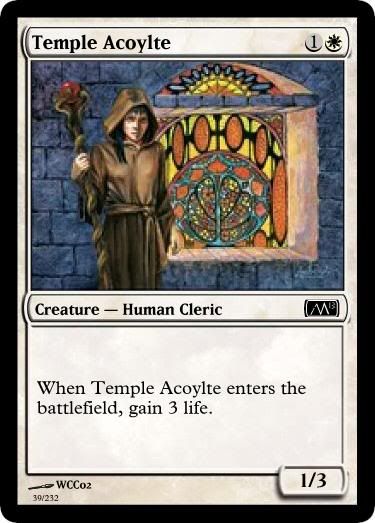 |
 |  |  | |
 |  | ||
 | 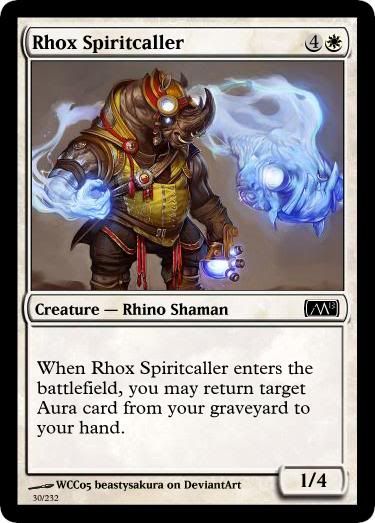 |
I hope you enjoyed this, and I hope it will be useful as we need to go through this same process again collectively.
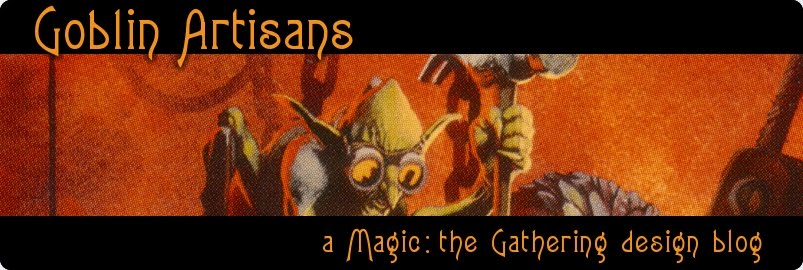
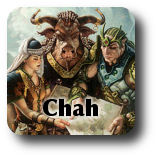




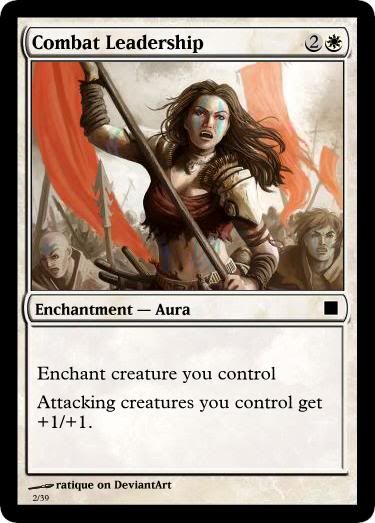

I'm loving the flavor text.
ReplyDeleteThe length and breadth of these development articles is truly impressive. Are you concerned that the ability White gives Green and Blue with it's bond ability is entirely absent from White's creatures? Whether we go with First strike, lifelink, or vigilance, that keyword should have a place in the white common creatures to ground it. I think that's another thing cards like Elephant Rider, Youthful Knight and Soldier Spirit were doing in the design file. Ideally, I think 1-2 creatures with the keyword would be best, as long at it doesn't screw up limited.
ReplyDeleteThanks, Nich.
DeleteWhile I was focused on things like assigning meaningful cards to vanilla slots and 1-drops, I hadn't been thinking enough about the number of french vanilla creatures.
We're probably doing Vigilance for plains bond. Maybe something like a 1/1 flying vigilance could fit in. Although actually I feel like we've been focusing so much on exposition (what these cards "show" to players) when normal mono-color core cards show what colors do better than Bond cards anyways. I think the strengths of the mechanic can be brought out in other ways.